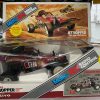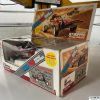The Metro Jet Hopper is a radio controlled car manufactured by Taiyo of Japan, and released onto the Australian market by GTI / Metro in the late 80s. This is the 2nd iteration, the Mark 2 with several improvements.

Successor to the original Jet Hopper
The release of the original 1986 Metro Jet Hopper was a smash hit, becoming wildly successful in Australia; so much so that Tyco of America recognized the opportunity and immediately engaged with the manufacturer (Taiyo) to begin production production of its own version, the Turbo Hopper.
Demand for the car in Japan, USA, and Europe remained high, leading to the production of this Mark II release in 1987.
In fact, photos of the original MK1 Jet Hopper remained on the box of all Jet Hopper / Turbo Hopper products (yes even the MK2, MK3) and it seems super obvious now - distinguishable by its 'fat' front tires!

How to identify Jet Hopper MK1, MK2, MK3?
The easiest way to identify a MK1, MK2 or MK3 is as follows:
MK1 - 'Jet Hopper' lettering cut out from the bumper. These may have extra thick front tires (very early cars), before eventually moving to the regular 'thin' front tires, all still considered MK1.
MK2 - Solid bumper. This is the easiest way to identify a MK1 Jet Hopper.
MK3 - Rear tires and eventually front and rear tires would change shape to a less bulbous 'flatter wider' tire, the same as used on the Heads Up Hopper and many others.

(Early MK1)



Features and Performance
The MK 2 included various enhancements, such as:
- Thinner and lighter front tires
- Increased top speed of 26km/h visibly marked in front of cockpit
- Solid front bumper (no embedded text)
- Power / Charge LED

Development of the Jet Hopper and Turbo Hopper, and its links to Australian toy industry legends is an interesting story.
We'd recommend reading the original MK1 article if you haven't already.
Do you need new tires?
It is very common for the rear, and sometimes the front tires on Jet Hopper / Turbo Hopper MK1 and MK2 to decompose due to rubber rot, and other issues with the materials used. They may go soft like play dough and fall apart, and later models such as the MK3 may go hard as rock. Thankfully after these years (1986-1988 roughly) it's much less of a problem and we don't see it in other cars.
For replacements, you may need to buy a parts car, if you can find one with good tires. Other than that, there are high quality 3D printed reproductions available. The best I've seen are from MCI Racing (not sponsored) and while I’ve not tried these myself yet, they seem better than anything else I've come across.
Rear Tires for Jet Hopper and Turbo Hopper MK1/MK2
https://mciracing.ca/products/1-14th-tyc-turbo-hopper-rear-tires
Front Tires for Jet Hopper and Turbo Hopper MK1/MK2
https://mciracing.ca/products/1-14th-tyc-turbo-hopper-front-tires
Availability and Collectability
Obtaining the Australian Metro Jet Hopper of any version is difficult, with relatively lower sales volumes compared to the US and Europe meaning any you do find are likely loved to bits, and in poor condition.
Tips for finding an Australia Metro RC Jet Hopper:
- Set a saved search on eBay Australia
- Keep an eye on Facebook marketplace
- Garage sales often have the best quality and prices
Whatever the case, owning one of these timeless Australian toys from the 80s is a nostalgic dream, and depending on the condition, a valuable collectible that will only appreciate in value over time.





























